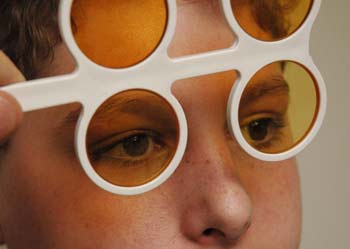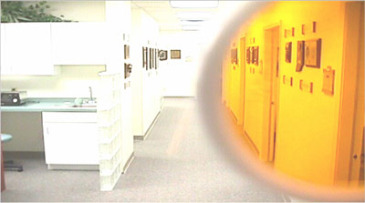Glare Assessment
Glare assessment begins with a careful history for poor glare recovery, sensitivity to  various glare sources and specific issues such as the effect of low lying sun orheadlights. Photostress or poor glare recovery and veiling glare can be assessed with a BAT, Brightness Acuity Tester. Trials with filters in lens flipper bars are used to test inside tints. The patient is taken outside to test the appropriate level of outside sun filter. During the behind-the-wheel training, specific glare issues may arise. The filter needed outside may need to be modified. Providing the driver's training specialist with a set of filters to test on patients in the car can be helpful.
various glare sources and specific issues such as the effect of low lying sun orheadlights. Photostress or poor glare recovery and veiling glare can be assessed with a BAT, Brightness Acuity Tester. Trials with filters in lens flipper bars are used to test inside tints. The patient is taken outside to test the appropriate level of outside sun filter. During the behind-the-wheel training, specific glare issues may arise. The filter needed outside may need to be modified. Providing the driver's training specialist with a set of filters to test on patients in the car can be helpful.
Problems with light and glare can endanger any driver. Uncontrolled glare may mask oncoming traffic and limit the ability to see signs and brake lights. Glare control is one of the most critical issues that must be dealt with for safe bioptic driving. Not controlling glare can lead to failure of an otherwise good bioptic driving candidate or make the driver less safe on the road.
Low vision patients vary on their light sensitivity. Some eye conditions require much more stringent control of light and glare. Safe driving in some patients requires a combination of careful control of glare and anticipation of potential glare problems in driving.
The low vision specialist will determine the degree of glare problems and appropriate treatments including sun filters, hats, visors and other adaptive steps. The low vision specialist may advise some patients to avoid driving just after sunrise and just before sunset, where low-lying sun might cause significant glare problems.
Three Types of Glare in Driving
Photostress or Poor Glare Recovery: When the energy of light bleaches out the chemicals in the retina, a temporary decrease in vision m ay occur. We all experience a brief form of this when we have a flash picture taken and notice a temporary spot in our vision. Patients with central retinal disorders like macular degeneration and Histoplasmosis may bleach-out severely and not quickly recover to their base vision.
ay occur. We all experience a brief form of this when we have a flash picture taken and notice a temporary spot in our vision. Patients with central retinal disorders like macular degeneration and Histoplasmosis may bleach-out severely and not quickly recover to their base vision.
Discomfort Glare or Photophobia: Discomfort glare is the visual discomfort or pain caused by very bright light such as direct sunlight or bright lamps. It can vary from mild annoyance to overwhelming pain.
Disability glare: Disability glare is the situation where vision is impaired by the excessive dazzle from a bright light source or reflection such as light reflecting from a glossy surface or from water. The degree of this impairment can vary from minor to severe.
